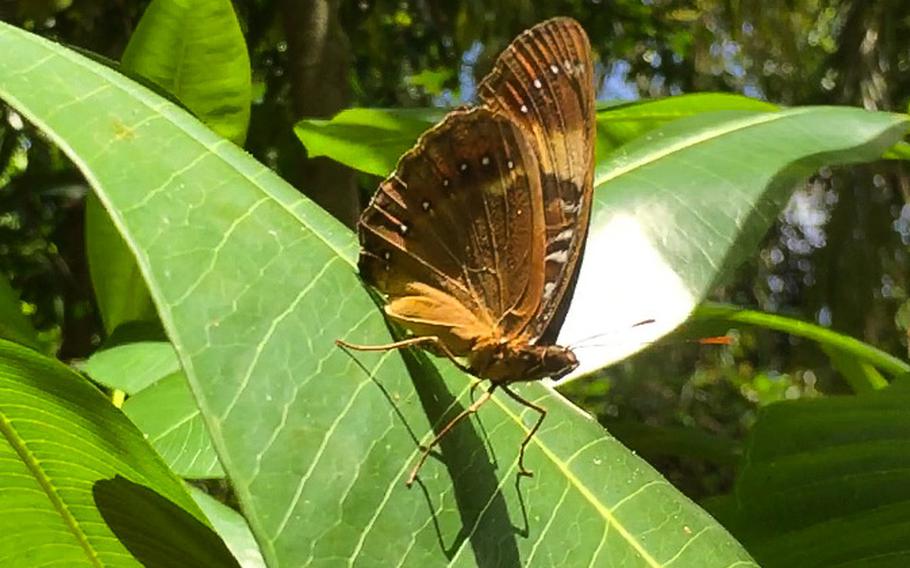
The Mariana eight-spot butterfly is an endangered species further threatened by construction of Camp Blaz on Guam, according to a lawsuit filed July 18, 2023, in U.S. District Court on the island. (U.S. Fish and Wildlife Service)
Environmental advocacy groups filed suit Tuesday seeking to force the Navy, Defense Department and U.S. Fish and Wildlife Service to protect endangered species on Guam from development of the Marine Corps’ newest installation, Camp Blaz.
The Navy and Fish and Wildlife Service failed “to protect and conserve more than a dozen endangered and threatened species at imminent risk of extinction on Guam,” according to a lawsuit filed Tuesday in U.S. District Court on Guam by the Center for Biological Diversity and Prutehi Litekyan: Save Ritidian.
The environmental groups seek a court order forcing the Navy to mitigate construction damage and reinitiate consultations with the Fish and Wildlife Service to protect Guam’s endangered plants and animals.
The Marines opened Blaz in January behind a requirement to mitigate damage to endangered species there when hundreds of forested acres were cleared for the base, according to the lawsuit.
The Fish and Wildlife Service in 2015 and 2017 outlined measures for the Navy under the Endangered Species Act to offset construction of Blaz against conservation of habitat for endangered plants and animals, said Maxx Phillips, a lawyer for the Center for Biological Diversity in Honolulu, by phone on Wednesday.
For example, the military was supposed to move 140 plants crucial to the life cycle of the endangered Mariana eight-spot butterfly but never did, and the butterfly is struggling as a result, she said.
The lawsuit claims construction at Camp Blaz destroyed 1,200 acres of Guam’s “last remaining” limestone forest and “is causing great harm to Guam’s endangered plants and animals including some of the most imperiled species in the world.”
Bulldozers took out acres of limestone forest, a unique ecosystem on Guam that harbors several endangered species, although an equal area of forest will be restored elsewhere, Adrienne Loerzel, Blaz’ forest enhancement program manager, said in April.
Phillips said a site visit to Blaz with a Navy escort showed the tree restoration project was failing, so far.
Camp Blaz took out an area previously designated part of the Guam National Wildlife Refuge and set aside to mitigate habitat lost to Andersen Air Force Base, according to a news release from the center Tuesday.
“It’s hard to understand why these culturally sensitive and ecologically sensitive areas were chosen for this development,” Phillips said.
Construction of the base Firing Range Complex at a place called Ritidian or Litekyan, is “devastating the once-pristine, biodiverse ecosystem” there, “one of the most ecologically and culturally sensitive places on Guam,” the 104-page lawsuit states.
A spokeswoman for Camp Blaz, Maj. Diann Rosenfeld, could not be reached by phone or email Wednesday for comment.
Guam figures prominently in U.S. strategy to offset the challenge presented by China’s growing military. The U.S. island territory south of Japan and east of the Philippines provides a power-projection and logistics platform in the western Pacific.
Camp Blaz is the first new Marine Corps installation since 1952 and covers 4,000 acres. About 5,000 Marines are expected to live and work at the base, along with family members.
The base is part of a plan to alleviate the burden of U.S. military bases felt by the population of Okinawa. Some of the Marines stationed at Guam will be relocated from Japan’s southernmost island prefecture.
In March, the Defense Department announced plans for a multi-million-dollar missile defense system on the island, for which planning, environmental studies and public input are underway. That project would entail 20 sites around the island where defensive missile batteries would rotate.